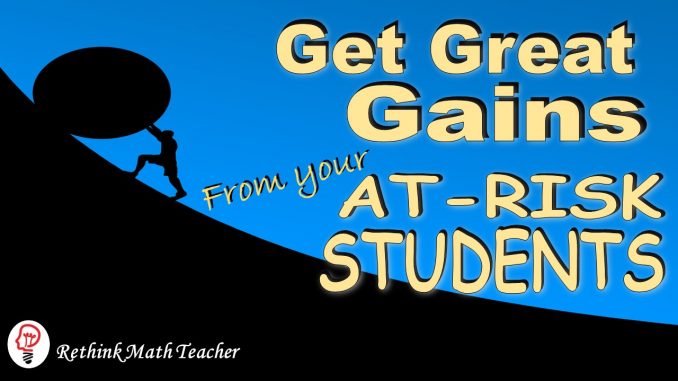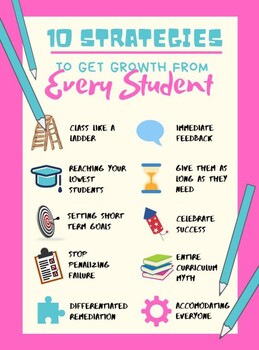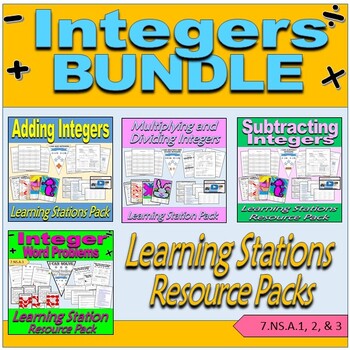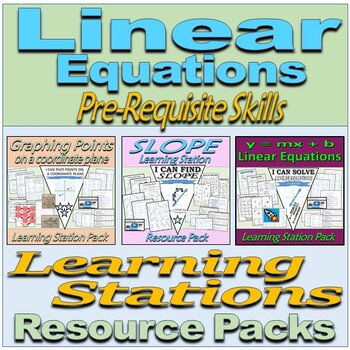
How I got a Room Full of At-Risk Students to Crush the State Scores

A Room Full of At-Risk Students
At my current school, I teach remedial math for students who are below grade level. My school intentionally gives me the lowest students in the school. So I typically have classes that are almost entirely in the bottom 25% of the state.
Did I mention I teach at a Title 1 school? (Title 1 means that most of our students are from families of low income). Yet by the end of the year, these classes full of at-risk students show incredible growth, and consistently outperform the state and district averages.
A free Growth Mindset Poster for your students, at the bottom of this post!
A Quick Talk about Data
How are your students’ test scores? How do they compare to the district, state, province, or country (depending upon where you live)?
My state has two measurements for the scores.
- Proficiency – the percent of students who are on grade level
- Learning Gains – the percent of students who show a year’s worth of progress
To be in the top tier of schools, and thus top tier of teachers, these two categories need to average 63%. The state average is always between 50-55% for these categories (regardless of what grade).
Understandably, teachers who have advanced students get high proficiency scores, but sometimes struggle on the learning gains. (Because if your student was high last year, and this year he is just on grade level, he still counts as proficient, but he didn’t show a year’s worth of gain).
And teachers with lower students do better with learning gains, but aren’t expected to do as well with proficiency scores since your student can show growth, but still not be on grade level.
Often, teachers with at-risk students – students who score in the bottom 25% of the state – struggle with both.

65% Proficiency
It is not uncommon for a room of at-risk students to score below 33% proficient (I’ve seen many classes get 0% proficient).
Yet my students consistently score in the mid 60 percent range! Remember if a school averages 63% they are in the top tier of schools! Also keep in mind that the average class, in my state, starts with about 50% of the students being proficient, and ends with 50% being proficient. I start with 0% and end with over 60%

Green = on grade-level, Yellow = below grade-level, Red = bottom 25% (at-risk)
In the typical classroom, half your students are on grade-level and half are below. At the end of the year, some students have changed places, but the percentages are the same.
In my classroom, none start on grade level and over 60% finish on grade level. Most start in the bottom 25% but almost all show growth.
Almost 100% Learning Gains
Each year I get closer and closer to 100% learning gains with my classes. I truly believe if I had not moved to administration, last year I would have got to 100% learning gains. But my last year in the room my students had learning gains that were almost 90%!!!
Why Do I Tell You This?
I share this information with you, my students’ remarkable results, because I am trying to present to you something counter-cultural. Something against the mold of traditional teaching.
Specifically, differentiation through learning stations.
My Secret
I have changed the way I teach. I used to pace the whole class through the majority of the curriculum, all at the same time. Much like a factory line. Everyone is treated the same, gets the same amount of practice, and then we all move on together. Regardless of whether or not everyone is ready to move on. Regardless of the fact that everyone is different, and some people require different amounts of practice on different concepts – or they haven’t mastered the prerequisite skills needed to do the grade level work.
I recently changed my perspective and realized that pacing everyone together often left many behind (and held many back). So now I focus on mastery! I give my students as long as they need on each concept before moving them to the next concept. I do this by differentiating my instruction with learning stations.

Share this article with your friends
Math Can Be Like a Ladder
Often, math concepts build upon each other. For example, you can’t convert an improper fraction to a mixed number if you can’t do long division. You can’t add fractions if you don’t know how to find the common denominator. And you can’t solve a two-step equation if you don’t know how to add and subtract integers.
Too often, we teach the first concept (like adding integers) and then move onto the next concept (subtracting integers) whether or not everyone’s ready. Because you can’t keep reteaching it to the whole class on account of a few students who still aren’t “getting it.” But if you have to be able to add integers in order to subtract them, those few who you’ve moved on without them mastering the first concept will never be able to master the second. But with learning stations, you can retain those few students in that first concept, while progressing the rest of the class.
Myth Busting
When I share with people; that I allow students as long as they need to master a concept. And that I don’t penalize them for mistakes. And that I differentiate instruction, using stations, to meet every student where they need support, I am met with lots of objections.
- It can’t be done.
- They won’t get through the entire curriculum.
- What if they never learn one skill.
- The class will all be working on different standards.
But it can be done. And when you do it, your students will be successful.
When you use learning stations the way we teach at Rethink Math Teacher, your students will master skills, gain confidence, and celebrate their success. All of which will help with the other issues facing your students (such as attendance, discipline, fear of math, etc.).
It Works
As mentioned in my opening paragraphs, I have had tremendous success using learning stations. My students loved it. They felt so proud of themselves each time they mastered a skill, and they knew that they were doing it because we were constantly celebrating their success. And this success gave them confidence and the desire to learn the next skill and the next.
Because of this renewed excitement, discipline was almost a non-factor.
I think often, students get into trouble because they don’t understand what they’re being taught, so they zone out, get distracted, or try to escape. But when everyone’s needs are being met, exactly where they are, and they feel their success, they’re much more likely to be engaged and much less likely to get into trouble.
Resources to Help You!
I’d love to help you help your students have the same success that mine have had. I have a page on the RethinkMathTeacher dedicated to resources on learning stations. I also have a book that will walk you through the process of creating and implementing your own learning stations, and an online course.

Share this post with your friends
Free growth mindset poster

Get all 5 Posters for $1 by clicking here
What to Read Next
- Differentiated Remediation
- Putting it All Together
- The Entire Curriculum Myth
- 21 Days to Be a Better Math Teacher
- Celebrate Your Students’ Success
- We Penalize Failure but Don’t Expect Mastery







I want to learn to reach every student
Hey Beth. Thanks for the comment. It can be done, and I hope to be able to guide you on this journey. Download the cheat sheet for more great resources.